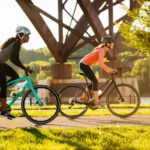Is determining the top speed of a dirt bike something that interests you? Dirt bike speed varies, but at usabikers.net, we’ll explore the factors influencing how fast a dirt bike can go, from engine size to rider skill, and help you understand the nuances of dirt bike performance. We’ll cover engine capacity, rider skill, and terrain.
1. What is the Top Speed of a Dirt Bike?
Dirt bikes can reach impressive speeds, with some models capable of exceeding 100 mph, but their typical speeds depend heavily on engine size, terrain, and rider skill. These bikes are rarely driven at top speed due to the rough terrain they are built for, but they can still match the speed of some on-road vehicles. Keep reading to delve into the specifics of dirt bike speeds, breaking down how different engine sizes affect performance and what factors limit these bikes’ top speeds in real-world conditions.
1.1. How Does Engine Size Affect Dirt Bike Speed?
Engine size, measured in cubic centimeters (cc), significantly impacts the speed of a dirt bike because a larger engine typically generates more power. A dirt bike’s engine can range from 50cc to 685cc, each tailored for different age groups and skill levels. According to the American Motorcyclist Association (AMA), understanding the relationship between engine size and speed is crucial for selecting the right bike.
1.2. What are the Typical Dirt Bike Speeds by Engine Size?
Typical dirt bike speeds vary widely based on engine size:
- 50cc Dirt Bikes: Ideal for children aged 3-7, reaching speeds up to 40 mph.
- 110cc Dirt Bikes: Suited for kids aged 7-10, with top speeds around 49 mph.
- 125cc Dirt Bikes: Designed for 10-13-year-olds, capable of reaching 60 mph.
- 150cc Dirt Bikes: Perfect for teenagers, also hitting speeds of 60 mph.
- 250cc Dirt Bikes: A great choice for taller teens and adults, achieving up to 70 mph.
- 450cc Dirt Bikes: Best for experienced adults, reaching speeds up to 87 mph.
This table summarizes how bike size correlates with rider age and potential speed:
| Age Group | Bike Size | Speed (mph) |
|---|---|---|
| 3 – 7 | 50cc | 40 |
| 7 – 10 | 110cc | 49 |
| 10 – 13 | 125cc | 60 |
| Teenagers | 150cc | 60 |
| Taller Teens/Adults | 250cc | 70 |
| Adults/Larger Adults | 450cc | 87 |
1.3. What Factors Can Limit the Top Speed of a Dirt Bike?
Several factors can limit the top speed of a dirt bike:
- Terrain: Rough and uneven surfaces require lower speeds for safety.
- Rider Skill: Less experienced riders may not handle high speeds effectively.
- Bike Setup: Incorrect gearing or suspension can reduce top speed.
- Weight: Heavier loads on the bike decrease overall performance.
2. How Does Dirt Bike Size Influence Speed and Performance?
When choosing a dirt bike, focusing on fit and experience level is more important than just the potential speed, as purchasing the fastest bike won’t matter if it’s the wrong size. Proper fit is crucial for control and safety. Adult bikes typically range from 230cc to 450cc, while younger riders use 50cc to 150cc models. Keep reading to understand the critical factors that affect a dirt bike’s speed and overall performance.
2.1. What is the Relationship Between Cubic Capacity (cc) and Dirt Bike Speed?
The cubic capacity (cc) of a dirt bike engine is directly related to its speed, meaning a larger cc generally results in a faster bike. Smaller dirt bikes often come with 110cc engines to provide an extra boost, and a heavier load on the bike can decrease its performance. Choosing the right cc for your skill level is essential for optimal performance and safety.
2.2. Why Does Rider Size Matter When Choosing a Dirt Bike?
Rider size is crucial when selecting a dirt bike because it affects the rider’s ability to control the bike effectively. According to the Motorcycle Safety Foundation (MSF), a bike that is too large or too small can compromise handling and increase the risk of accidents. Ensuring the rider can comfortably reach the controls and maintain balance is vital for a safe riding experience.
2.3. What are the Physical Demands of Riding a Fast Dirt Bike?
Riding a fast dirt bike requires significant physical and mental endurance because motocross riders are among the fittest athletes in the world. The constant need to adjust to rough terrain and maintain control at high speeds demands strength, agility, and quick reflexes. Training and physical conditioning are essential for riders looking to maximize their performance and safety.
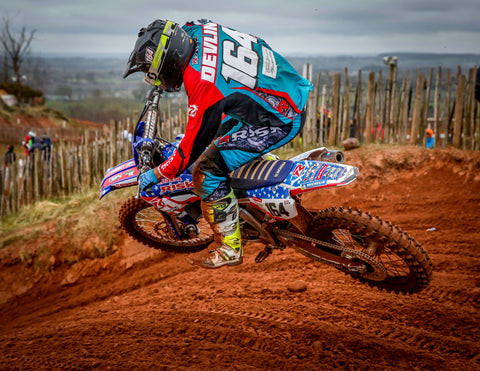 Rider controlling motocross bike on a dirt track, demonstrating skill and agility
Rider controlling motocross bike on a dirt track, demonstrating skill and agility
3. Two-Stroke vs. Four-Stroke Dirt Bikes: Which is Faster?
The debate between two-stroke and four-stroke dirt bikes often centers on their distinct riding styles and performance characteristics; both types have unique advantages depending on the rider’s preferences and the riding conditions. Two-strokes are known for their hard-hitting power and lighter weight, while four-strokes offer smoother power delivery and greater durability. Read on to explore the differences between two-stroke and four-stroke dirt bikes, highlighting the features that impact speed and handling.
3.1. What are the Key Features of Two-Stroke Dirt Bikes?
Two-stroke dirt bikes have unique features that impact their performance:
- Hard-hitting Power Band: Delivers strong acceleration in a narrow RPM range.
- Lighter Weight: Enhances maneuverability and acceleration.
- Faster Acceleration: Due to the lighter engine.
- Frequent Gear Changes: Requires more active gear management.
- Premixing of Oil and Fuel: Necessary for engine lubrication.
3.2. What are the Benefits of Four-Stroke Dirt Bikes?
Four-stroke dirt bikes offer different advantages:
- Smooth, Consistent Power Delivery: Provides predictable power across the RPM range.
- Greater Durability: Engines are more robust and last longer.
- Complex Design: More intricate engine design than two-strokes.
3.3. Which Type of Engine is Generally Faster?
Generally, two-stroke engines offer quicker acceleration due to their lighter weight and more immediate power delivery, making them potentially faster in short bursts. However, four-stroke engines provide more consistent power and better control, which can be advantageous in longer races. The choice depends on the rider’s skill and the specific demands of the riding environment.
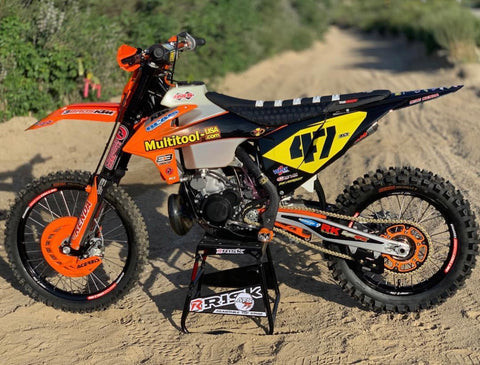 Close-up of a two-stroke dirt bike engine showcasing its simple and lightweight design
Close-up of a two-stroke dirt bike engine showcasing its simple and lightweight design
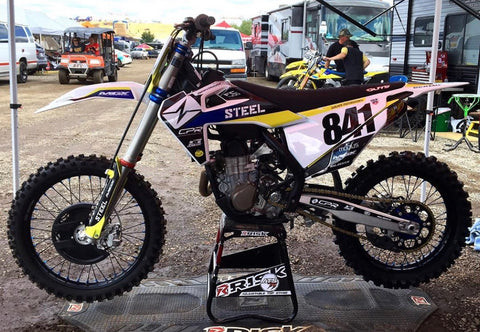 Four-stroke dirt bike engine illustrating its complex and durable construction
Four-stroke dirt bike engine illustrating its complex and durable construction
4. What are the Fastest Dirt Bikes in the World?
Several manufacturers have engineered high-performance dirt bikes that stand out for their exceptional speed and power. Models like the KTM 450 SX-F, Beta 450RS, and Honda XR 650cc are renowned for their top speeds and advanced engineering. Let’s take a closer look at these top contenders, examining what makes them the fastest dirt bikes available.
4.1. KTM 450 SX-F: Specs and Performance
The KTM 450 SX-F is known for its top-tier engine power and responsiveness, making it a favorite among professional racers like Ryan Dungey. It features a 449cc engine, providing immediate throttle response and impressive acceleration. With speeds up to 123 mph, it’s one of the fastest motocross bikes in the world.
4.2. Beta 450RS: Speed and Street-Legal Features
The Beta 450RS reaches a maximum speed of 110 mph and can accelerate from 0 to 60 mph in just over 5 seconds. This model is street-legal in all 50 U.S. states, offering versatility for both on-road and off-road riding. Its foldable mirrors make it ideal for transitioning between street and dirt environments.
4.3. Honda XR 650cc: A Desert Racing Legend
The Honda XR 650cc is designed for long-range desert races, featuring a robust four-stroke engine. Introduced in 2000, it remains a sought-after dirt bike for its reliability and speed, reaching up to 110 mph. Its durable construction and powerful engine make it a favorite for challenging terrains.
 KTM 450 SX-F on a dirt track showcasing its powerful engine and agility
KTM 450 SX-F on a dirt track showcasing its powerful engine and agility
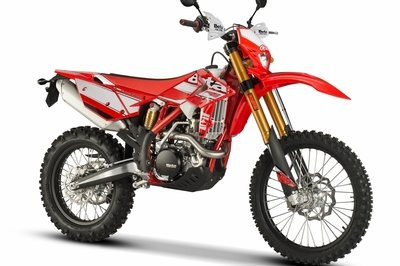 Beta 450RS in a street setting with foldable mirrors, highlighting its dual-sport capabilities
Beta 450RS in a street setting with foldable mirrors, highlighting its dual-sport capabilities
 Honda XR 650cc in a desert landscape, demonstrating its durability and long-range capabilities
Honda XR 650cc in a desert landscape, demonstrating its durability and long-range capabilities
5. What are the Most Important Factors in Choosing a Dirt Bike?
While speed is a consideration, the most important factors in choosing a dirt bike are rider size, skill level, and intended use. A bike that fits well and matches your experience will provide better control and safety. Usabikers.net offers resources and community support to help you make the right choice, ensuring you get the most out of your riding experience. Continue reading to learn how to balance speed with other crucial factors for optimal dirt bike performance.
5.1. How Does Rider Skill Level Impact Dirt Bike Choice?
Rider skill level significantly impacts dirt bike choice, as beginners should opt for smaller, more manageable bikes, while experienced riders can handle larger, more powerful models. The American Motorcyclist Association (AMA) recommends that novice riders start with bikes that offer smooth power delivery and easy handling to build confidence and control. Choosing a bike that matches your skill level ensures a safer and more enjoyable riding experience.
5.2. Why is Proper Fit More Important Than Speed?
Proper fit is more important than speed because it directly affects the rider’s ability to control the bike. A bike that is too tall or too heavy can be difficult to handle, leading to accidents. Ensuring you can comfortably reach the controls, maintain balance, and maneuver the bike is crucial for safety and performance.
5.3. How Can You Improve Your Dirt Bike Riding Skills?
You can improve your dirt bike riding skills through various methods, including:
- Professional Training: Enrolling in courses offered by the Motorcycle Safety Foundation (MSF) can provide essential skills and techniques.
- Practice: Regular practice in controlled environments helps build muscle memory and confidence.
- Fitness Training: Improving your physical fitness enhances your ability to handle the bike and endure longer rides.
- Community Involvement: Joining riding clubs and participating in group rides offers opportunities to learn from experienced riders.
6. What are the Safety Considerations When Riding a Fast Dirt Bike?
Riding a fast dirt bike requires strict adherence to safety protocols. Always wear appropriate safety gear, including a helmet, goggles, gloves, and protective clothing. Inspect your bike before each ride to ensure it is in good working condition. According to the Motorcycle Safety Foundation (MSF), proper training and awareness of your surroundings are crucial for preventing accidents. Discover more safety tips and best practices at usabikers.net.
6.1. What Safety Gear is Essential for Dirt Bike Riding?
Essential safety gear for dirt bike riding includes:
- Helmet: Protects the head from impact.
- Goggles: Shield the eyes from dust and debris.
- Gloves: Provide grip and protect the hands.
- Boots: Offer ankle and foot support.
- Protective Clothing: Includes padded jackets, pants, and body armor.
6.2. How Can You Ensure Your Dirt Bike is Safe to Ride?
To ensure your dirt bike is safe to ride, perform regular maintenance checks:
- Tire Condition: Check for wear and proper inflation.
- Brake Function: Ensure brakes are responsive and effective.
- Fluid Levels: Monitor oil, coolant, and brake fluid levels.
- Chain Tension: Maintain proper chain tension for smooth power delivery.
- Suspension: Inspect suspension components for leaks or damage.
6.3. What are the Common Causes of Dirt Bike Accidents?
Common causes of dirt bike accidents include:
- Rider Error: Lack of experience or improper technique.
- Excessive Speed: Riding beyond your skill level or the terrain’s limits.
- Obstacles: Colliding with rocks, trees, or other riders.
- Mechanical Failure: Malfunctioning brakes, suspension, or engine components.
- Poor Visibility: Riding in low-light conditions or dusty environments.
7. How Does Terrain Affect the Speed of a Dirt Bike?
Terrain plays a significant role in determining the speed of a dirt bike. Smooth, flat surfaces allow for higher speeds, while rough, uneven terrain requires slower speeds for control and safety. Different types of terrain, such as sand, mud, and rocky trails, present unique challenges that affect a bike’s performance. Explore usabikers.net for tips on adjusting your riding technique for various terrains.
7.1. What Types of Terrain Allow for the Highest Speeds?
Terrain that allows for the highest speeds typically includes:
- Hard-Packed Dirt: Provides good traction and stability.
- Groomed Tracks: Designed for racing with smooth surfaces.
- Dry Conditions: Minimizes slippage and improves control.
7.2. How Does Mud and Sand Impact Dirt Bike Speed?
Mud and sand significantly reduce dirt bike speed due to:
- Reduced Traction: Makes it harder to accelerate and brake.
- Increased Resistance: Requires more power to maintain momentum.
- Unstable Handling: Causes the bike to slide and lose control.
7.3. What Techniques Can Improve Riding in Challenging Terrain?
Techniques to improve riding in challenging terrain include:
- Maintaining Momentum: Keeping a steady pace to avoid getting stuck.
- Adjusting Tire Pressure: Lowering tire pressure for better traction in sand.
- Using Body Weight: Shifting weight to maintain balance and control.
- Reading the Terrain: Anticipating obstacles and adjusting your path accordingly.
- Proper Gear Selection: Choosing the right gear for optimal power delivery.
8. What Are Some Upgrades to Increase Dirt Bike Speed?
While engine size is a primary factor, several upgrades can enhance a dirt bike’s speed and performance. Upgrades such as exhaust systems, carburetors, and suspension modifications can improve power and handling. Always consult with a professional before making significant changes to ensure compatibility and safety. Visit usabikers.net for expert advice on dirt bike modifications and performance enhancements.
8.1. How Can Exhaust Systems Improve Dirt Bike Performance?
Exhaust systems can improve dirt bike performance by:
- Increasing Power: Allowing the engine to breathe more efficiently.
- Reducing Weight: Lighter materials improve overall performance.
- Enhancing Throttle Response: Providing quicker acceleration.
8.2. What Role Do Carburetors Play in Dirt Bike Speed?
Carburetors play a crucial role in dirt bike speed by:
- Optimizing Fuel Delivery: Ensuring the engine receives the correct air-fuel mixture.
- Improving Throttle Response: Providing quicker acceleration.
- Increasing Power Output: Enhancing overall engine performance.
8.3. How Does Suspension Affect Dirt Bike Handling and Speed?
Suspension affects dirt bike handling and speed by:
- Improving Stability: Maintaining control on rough terrain.
- Enhancing Traction: Keeping the tires in contact with the ground.
- Absorbing Impacts: Reducing rider fatigue and improving comfort.
9. What are the Fastest Growing Trends in Dirt Bike Technology?
Dirt bike technology is constantly evolving, with new trends emerging to enhance performance, safety, and rider experience. Electric dirt bikes, advanced suspension systems, and rider-assist technologies are gaining popularity. These innovations promise to transform the future of dirt bike riding. Stay updated on the latest trends and technological advancements at usabikers.net.
9.1. How Are Electric Dirt Bikes Changing the Industry?
Electric dirt bikes are changing the industry by:
- Reducing Emissions: Offering a more environmentally friendly alternative.
- Providing Instant Torque: Delivering quick acceleration.
- Lowering Maintenance: Reducing the need for oil changes and other routine maintenance.
- Reducing Noise Pollution: Creating a quieter riding experience.
9.2. What Advancements Are Being Made in Suspension Technology?
Advancements in suspension technology include:
- Electronic Suspension: Automatically adjusts damping based on terrain and riding conditions.
- Air Suspension: Offers lightweight and adjustable performance.
- Improved Materials: Enhancing durability and reducing weight.
9.3. What Rider-Assist Technologies Are Emerging in Dirt Biking?
Emerging rider-assist technologies in dirt biking include:
- Traction Control: Prevents wheel spin and maintains control.
- Launch Control: Optimizes acceleration from a standstill.
- GPS Navigation: Provides route guidance and tracking.
- Data Logging: Records performance metrics for analysis and improvement.
10. Where Can You Find More Information and Connect with Other Dirt Bike Enthusiasts?
For more information on dirt bikes, riding tips, and community events, visit usabikers.net. Our website offers a wealth of resources, including articles, reviews, and forums where you can connect with other enthusiasts. Whether you’re a beginner or an experienced rider, usabikers.net is your go-to source for all things dirt bike related. Join our community today and share your passion for riding!
10.1. What Resources Does Usabikers.net Offer?
Usabikers.net offers a variety of resources, including:
- Detailed Articles and Guides: Covering various topics from bike maintenance to riding techniques.
- Bike Reviews: Providing unbiased assessments of different models.
- Community Forums: Connecting riders to share experiences and advice.
- Event Listings: Keeping you informed about local and national dirt bike events.
10.2. How Can You Connect with Other Dirt Bike Riders?
You can connect with other dirt bike riders through:
- Usabikers.net Forums: Participate in discussions and share your experiences.
- Local Riding Clubs: Join clubs for organized rides and social events.
- Social Media Groups: Connect with riders on platforms like Facebook and Instagram.
- Dirt Bike Events: Attend races and rallies to meet fellow enthusiasts.
10.3. How Can Usabikers.net Help You Improve Your Riding Experience?
Usabikers.net can help you improve your riding experience by:
- Providing Expert Advice: Offering tips and techniques from experienced riders.
- Keeping You Informed: Staying up-to-date on the latest trends and technologies.
- Connecting You with the Community: Sharing knowledge and experiences with other riders.
- Offering Access to Resources: Providing tools and information to enhance your skills and enjoyment.
Join usabikers.net today to explore articles, participate in forums, and connect with a vibrant community of riders. Discover more about the perfect dirt bike for your needs and skill level. Your ultimate riding adventure starts here!
Address: 801 Sturgis Main St, Sturgis, SD 57785, United States
Phone: +1 (605) 347-2000
Website: usabikers.net
FAQ: Dirt Bike Speed
Q1: How fast can a 250cc dirt bike go?
A: A 250cc dirt bike can typically reach speeds of up to 55-70 mph, depending on the model, terrain, and rider skill. These bikes are a popular choice for teenagers and adults looking for a balance of power and maneuverability.
Q2: What is the top speed of a 450cc dirt bike?
A: A 450cc dirt bike can reach top speeds of around 87 mph, making them suitable for experienced adult riders. These bikes offer significant power and are often used in professional motocross racing.
Q3: Are two-stroke or four-stroke dirt bikes faster?
A: Two-stroke dirt bikes generally offer quicker acceleration due to their lighter weight and more immediate power delivery, while four-stroke bikes provide more consistent power and better control. The faster choice depends on the rider’s skill and the specific demands of the riding environment.
Q4: What factors limit the top speed of a dirt bike?
A: The top speed of a dirt bike can be limited by factors such as terrain, rider skill, bike setup, and weight. Rough terrain requires lower speeds for safety, while less experienced riders may struggle to handle high speeds effectively.
Q5: Is it safe to ride a dirt bike at its maximum speed?
A: Riding a dirt bike at its maximum speed can be dangerous, especially on challenging terrain or without proper safety gear and training. It’s essential to ride within your skill level and always prioritize safety.
Q6: How does rider size affect the choice of a dirt bike?
A: Rider size is crucial when selecting a dirt bike because it affects the rider’s ability to control the bike effectively. A bike that is too large or too small can compromise handling and increase the risk of accidents.
Q7: What safety gear is essential for riding a fast dirt bike?
A: Essential safety gear for riding a fast dirt bike includes a helmet, goggles, gloves, boots, and protective clothing such as padded jackets, pants, and body armor. Proper gear can significantly reduce the risk of injury in case of an accident.
Q8: How can I improve my dirt bike riding skills?
A: You can improve your dirt bike riding skills through professional training, regular practice in controlled environments, fitness training, and community involvement by joining riding clubs and participating in group rides.
Q9: What are the benefits of joining a dirt bike community like Usabikers.net?
A: Joining a dirt bike community like usabikers.net provides access to expert advice, the latest industry information, connections with other riders, and resources to enhance your skills and enjoyment of the sport.
Q10: Can upgrading my dirt bike increase its speed?
A: Yes, several upgrades can enhance a dirt bike’s speed and performance, including exhaust systems, carburetors, and suspension modifications. However, it’s essential to consult with a professional before making significant changes to ensure compatibility and safety.

